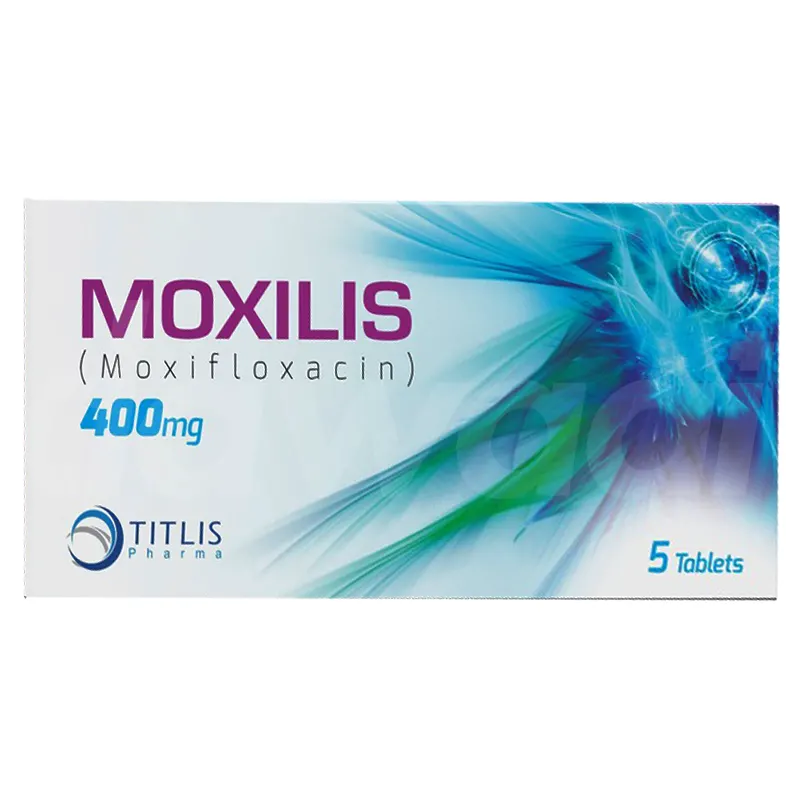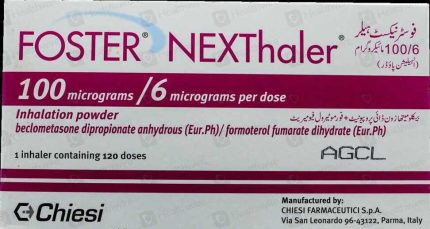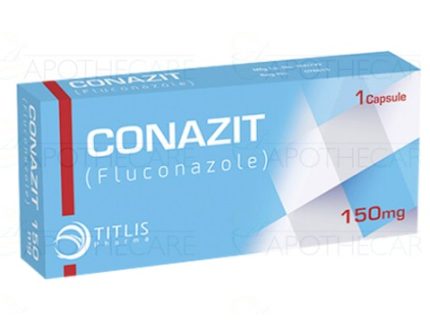Here’s a detailed description of **MOXILIS (Moxifloxacin) 400mg tablets**:
1. **What it is:** A prescription antibiotic medication.
* **Generic Name:** Moxifloxacin Hydrochloride
* **Brand Name:** MOXILIS (one of many brand names; others include Avalox, Avelox)
* **Drug Class:** Fluoroquinolone Antibiotic (4th generation)
* **Dosage Form:** Tablet
* **Strength:** 400 mg per tablet
2. **Mechanism of Action (How it works):** Moxifloxacin kills bacteria (bactericidal) by inhibiting two essential bacterial enzymes: **DNA gyrase (Topoisomerase II)** and **Topoisomerase IV**. This prevents bacterial DNA from unwinding, replicating, and repairing itself, leading to bacterial cell death.
3. **Indications (What it’s used for):** Treatment of susceptible bacterial infections in adults, including:
* **Acute Bacterial Sinusitis (ABS):** Caused by *Streptococcus pneumoniae*, *Haemophilus influenzae*, or *Moraxella catarrhalis*.
* **Acute Bacterial Exacerbation of Chronic Bronchitis (AECB):** Caused by *Streptococcus pneumoniae*, *Haemophilus influenzae*, *Haemophilus parainfluenzae*, *Klebsiella pneumoniae*, *Staphylococcus aureus*, or *Moraxella catarrhalis*.
* **Community-Acquired Pneumonia (CAP):** Caused by *Streptococcus pneumoniae* (including multi-drug resistant strains), *Haemophilus influenzae*, *Moraxella catarrhalis*, *Mycoplasma pneumoniae*, *Chlamydophila pneumoniae*, or *Legionella pneumophila*. *Note: Due to safety concerns, fluoroquinolones like moxifloxacin are generally reserved for CAP when other appropriate alternatives cannot be used.*
* **Uncomplicated Skin and Skin Structure Infections (uSSSI):** Caused by *Staphylococcus aureus* or *Streptococcus pyogenes*.
* **Complicated Skin and Skin Structure Infections (cSSSI):** Caused by susceptible isolates of *Staphylococcus aureus*, *Escherichia coli*, *Klebsiella pneumoniae*, or *Enterobacter cloacae*.
* **Complicated Intra-Abdominal Infections (cIAI):** Used in combination with other antibiotics, caused by *Escherichia coli*, *Bacteroides fragilis*, *Streptococcus anginosus*, *Streptococcus constellatus*, *Enterococcus faecalis*, *Proteus mirabilis*, *Clostridium perfringens*, *Bacteroides thetaiotaomicron*, or *Peptostreptococcus* species.
4. **Dosage & Administration:**
* **Standard Dose:** **One 400 mg tablet taken once daily.**
* **Route:** Oral (by mouth).
* **Duration:** Varies depending on the infection type and severity (typically 5-14 days). **Crucially, the full prescribed course must be completed, even if symptoms improve earlier, to prevent antibiotic resistance and relapse.**
* **Timing:** Can be taken with or without food. Avoid taking with dairy products, calcium-fortified juices, antacids (containing magnesium, aluminum, calcium), sucralfate, iron supplements, multivitamins containing zinc or iron, or didanosine chewable/buffered tablets within 4 hours before or 8 hours after taking moxifloxacin, as these can significantly reduce its absorption.
* **Hydration:** Drink fluids liberally while taking it.
5. **Key Warnings & Precautions (Serious Risks):** Fluoroquinolones, including moxifloxacin, carry **Boxed Warnings (the strongest FDA warning)** regarding:
* **Tendinitis and Tendon Rupture:** Risk is increased in all ages, but especially in those over 60, on corticosteroids, or with organ transplants (kidney, heart, lung). Rupture can occur during or after treatment, even months later. Discontinue immediately if pain, swelling, or inflammation in a tendon occurs; avoid exercise.
* **Peripheral Neuropathy:** Irreversible sensory or sensorimotor neuropathy (nerve damage causing pain, burning, tingling, numbness, weakness) can occur rapidly. Discontinue at first signs.
* **Central Nervous System (CNS) Effects:** May cause dizziness, lightheadedness, confusion, tremors, hallucinations, depression, suicidal thoughts, seizures, increased intracranial pressure. Use caution in patients with CNS disorders or epilepsy. May impair mental alertness (avoid driving/operating machinery if affected).
* **Exacerbation of Myasthenia Gravis:** Can cause severe weakness and respiratory failure in patients with this neuromuscular disorder. **Contraindicated.**
6. **Other Important Warnings & Precautions:**
* **QT Prolongation & Torsades de Pointes:** May prolong the QT interval on ECG, increasing risk of a dangerous heart rhythm. Avoid in patients with known QT prolongation, uncorrected electrolyte imbalances (low potassium/magnesium), significant bradycardia, or on other QT-prolonging drugs. Use caution in those with heart failure or taking Class IA/III antiarrhythmics.
* **Hypersensitivity Reactions:** Severe allergic reactions (anaphylaxis), sometimes after the first dose, can occur. Discontinue at first sign of rash, hives, swelling, or difficulty breathing.
* **Hepatotoxicity:** Severe liver injury (including hepatitis, liver failure) has been reported. Monitor for symptoms (jaundice, dark urine, abdominal pain).
* **Clostridium difficile-Associated Diarrhea (CDAD):** Can cause severe, potentially fatal colitis during or months after treatment. Discontinue if significant diarrhea occurs.
* **Photosensitivity/Phototoxicity:** Increased risk of sunburn; avoid excessive sun/UV light; use sunscreen/protective clothing.
* **Blood Glucose Disturbances:** Hyperglycemia (high blood sugar) or hypoglycemia (low blood sugar), especially in diabetics on insulin/oral agents. Monitor blood sugar closely.
* **Aortic Aneurysm/Dissection:** Fluoroquinolones may increase the risk, especially in the elderly or those with risk factors (e.g., hypertension, atherosclerosis).
* **Resistance:** Should only be used for infections proven or strongly suspected to be caused by susceptible bacteria to prevent antibiotic resistance.
7. **Common Side Effects:**
* Nausea, diarrhea, vomiting, abdominal pain
* Dizziness, headache
* Constipation
* Insomnia
* Increased liver enzymes (transaminases)
8. **Contraindications (When it MUST NOT be used):**
* Known hypersensitivity to moxifloxacin, other quinolones, or any component.
* History of tendon rupture or tendinitis related to fluoroquinolone use.
* Patients with **myasthenia gravis** (risk of life-threatening exacerbation).
9. **Drug Interactions:** Numerous and significant. Inform your doctor about ALL medications/supplements you take, especially:
* **QT-Prolonging Drugs:** Antiarrhythmics (amiodarone, sotalol, quinidine, procainamide), antipsychotics, tricyclic antidepressants, macrolides, others.
* **Corticosteroids:** Increase risk of tendon rupture.
* **Antacids/Minerals:** Reduce absorption (see Timing above).
* **Warfarin:** May increase bleeding risk (monitor INR closely).
* **Oral Hypoglycemics/Insulin:** Risk of hypo/hyperglycemia.
* **NSAIDs:** May increase CNS stimulation/seizure risk.
* **Probenecid:** May increase moxifloxacin levels.
10. **Storage:** Store at room temperature (15-30°C / 59-86°F) in a dry place, protected from light and moisture. Keep in the original container.
11. **Missed Dose:** Take it as soon as you remember. If it’s almost time for the next dose, skip the missed dose and take the next one at the regular time. **Do not double the dose.**
**In Summary:** MOXILIS 400mg is a potent fluoroquinolone antibiotic (moxifloxacin) used once daily for specific serious bacterial infections like pneumonia, sinusitis, bronchitis, and skin/abdominal infections. **It carries significant and potentially serious risks (tendon rupture, nerve damage, CNS effects, heart rhythm changes), highlighted by Boxed Warnings.** Its use is generally reserved for infections where benefits outweigh these risks and safer alternatives are not appropriate. Strict adherence to dosing instructions and awareness/prompt reporting of side effects are crucial. **Always use exactly as prescribed by your doctor.**






Reviews
There are no reviews yet.